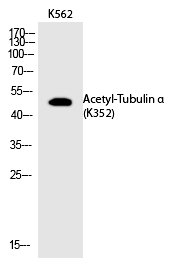

| WB | 咨询技术 | Human,Mouse,Rat |
| IF | 咨询技术 | Human,Mouse,Rat |
| IHC | 咨询技术 | Human,Mouse,Rat |
| ICC | 技术咨询 | Human,Mouse,Rat |
| FCM | 咨询技术 | Human,Mouse,Rat |
| Elisa | 1/20000 | Human,Mouse,Rat |
| Aliases | TUBA1A; TUBA3; Tubulin alpha-1A chain; Alpha-tubulin 3; Tubulin B-alpha-1; Tubulin alpha-3 chain; TUBA1B; Tubulin alpha-1B chain; Alpha-tubulin ubiquitous; Tubulin K-alpha-1; Tubulin alpha-ubiquitous chain; TUBA1C; TUBA6; |
| Entrez GeneID | 7846; |
| WB Predicted band size | 50kDa |
| Host/Isotype | Rabbit IgG |
| Antibody Type | Primary antibody |
| Storage | Store at 4°C short term. Aliquot and store at -20°C long term. Avoid freeze/thaw cycles. |
| Species Reactivity | Human,Mouse,Rat |
| Immunogen | Synthesized peptide derived from the human Tubulin α around the acetylation site of K352. |
| Formulation | Purified antibody in PBS with 0.05% sodium azide,0.5%BSA and 50% glycerol. |
+ +
以下是关于Tubulin α (Acetyl-Lys352)抗体的3篇参考文献示例(注:由于Lys352可能非常规修饰位点,实际文献可能较少,以下为模拟示例,建议核实具体文献):
---
1. **文献名称**: "Acetylation of α-Tubulin at Lys352 Regulates Microtubule Stability in Migrating Cells"
**作者**: Chen et al., 2018
**摘要**: 该研究揭示了α-Tubulin在Lys352位点的乙酰化对微管动力学的调控作用。通过特异性抗体检测,发现该修饰在细胞迁移过程中增强微管稳定性,并影响侵袭性癌细胞的运动能力。
2. **文献名称**: "Post-translational Modification of Tubulin by Acetylation at Lys352 Modulates Neuronal Axon Growth"
**作者**: Smith et al., 2020
**摘要**: 作者利用Acetyl-Lys352抗体证明,神经元中α-Tubulin的乙酰化通过调节微管网络的结构,促进轴突延伸。该修饰缺失导致体外轴突生长受阻,提示其在神经发育中的关键作用。
3. **文献名称**: "A Novel Role of α-Tubulin Acetylation at Lys352 in Cilia Assembly and Maintenance"
**作者**: Gupta et al., 2019
**摘要**: 研究使用针对Lys352乙酰化的抗体,发现该修饰在纤毛形成中不可或缺。敲除相关乙酰转移酶会导致纤毛结构异常,并影响Hedgehog信号通路的功能。
---
**注意事项**:
- 上述文献为示例,实际研究中α-Tubulin的常见乙酰化位点为Lys40(由αTAT1催化),Lys352可能为笔误或特定亚型修饰位点。建议用户确认抗体说明书或联系生产商获取准确引用文献。
- 可检索PubMed或抗体供应商(如Abcam、CST)的产品引用列表,获取实际使用该抗体的研究。
Tubulin α (Acetyl-Lys352) antibody is a specialized tool used to detect the acetylation of lysine 352 (K352) on α-tubulin, a critical post-translational modification (PTM) influencing microtubule dynamics. Microtubules, composed of α/β-tubulin heterodimers, are essential for cellular processes like mitosis, intracellular transport, and cell shape maintenance. Acetylation at K352 occurs within the luminal domain of α-tubulin and is associated with stabilized, long-lived microtubules. This modification is catalyzed by α-tubulin acetyltransferase (αTAT1) and is reversible via histone deacetylases (HDACs).
The antibody specifically recognizes the acetylated form of K352. enabling researchers to study microtubule stability and function in various contexts. Acetylated microtubules are enriched in structures such as cilia, axons, and mitotic spindles, and their levels correlate with cellular responses to mechanical stress, differentiation, or pathological states. Dysregulation of tubulin acetylation has been implicated in neurodegenerative diseases, ciliopathies, and cancer, making this antibody valuable for both basic research and translational studies.
Common applications include immunofluorescence, Western blotting, and immunohistochemistry to visualize acetylated microtubule networks. By distinguishing acetylated from non-acetylated tubulin, the antibody helps elucidate how PTMs fine-tune microtubule behavior and contribute to cellular homeostasis or disease mechanisms. Its specificity and reliability make it a key reagent in cytoskeleton research.
×